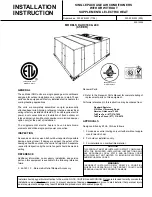
NOTES
•
If the number of indoor units to be connected is less than the number of branch ports (so that there are
empty branch ports left, or if you plan to increase the number in the future), any of the branch ports
can be left open.
•
If you plan to add new indoor units in the future, select a pipe size based on the total indoor unit capac-
ity before addition of new units.
• For more information about how to install the stop valve kit for extension, refer to the installation man
-
ual included with the stop valve kit for extension.
5-2 Pipe connection work precautions
Connect the pipes.
• Braze (*2) refrigerant pipes after nitrogen replacement (replacing air and nitrogen while allowing nitro
-
gen to flow inside the refrigerant pipe (*1)). (
Refer to Fig. 2.)
(*1) The pressure regulator for the nitrogen released when doing the brazing should be set to about 2.9
psi (0.02 MPa) (enough to feel a slight breeze on your cheek).
(*2) Do not use flux when brazing the refrigerant pipe.
Use phosphor copper (B-Cu93P-710/795: ISO 3677), which does not require flux, as the filler
metal for brazing.
(Using chlorine flux may cause the pipes to corrode, and if it contains fluoride it may cause the
refrigerant lubricant to degrade, adversely affecting the refrigerant piping system.)
Location of brazing
Nitrogen
Refrigerant pipe
Valve
Taping
Nitrogen
Pressure regulator
Fig. 2
CAUTION
• Do not use an anti-oxidizing agent when brazing the piping.
(Residual debris could clog the piping or cause parts to malfunction.)
•
For more information about outdoor unit refrigerant pipes, see the installation manual included with the
outdoor unit or the Engineering Guide.
(Failure to purge air from the pipes or fill additional refrigerant may result in an insufficient volume of
refrigerant in the pipes or other problems, causing the equipment to malfunction [for example, to not
cool or heat properly].)
8
3P405106-9 English
01_EN_3P405106-9.indb 8
3/27/2015 1:53:10 PM







































